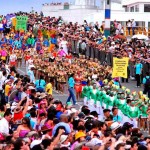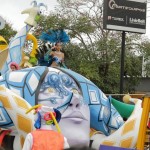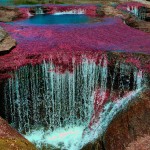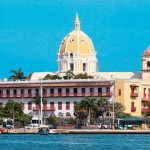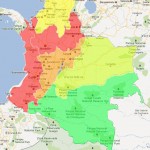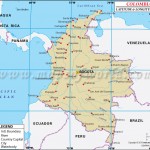List of the Intangible Cultural Heritage of Humanity – Colombia
UNESCO established its lists of Intangible Cultural Heritage with the aim of ensuring the better protection of important intangible cultural heritages worldwide and the awareness of their significance.
Colombia boasts sites, cultures and landscapes that have been recognized by the international community. UNESCO declared the following assets of the Intangible Cultural Heritage of Humanity:
Carnival of Barranquilla

Carnival of Barranquilla
Every year during the four days before Lent, the Carnival de Barranquilla offers a repertory of dances and musical expressions originating from different Colombian sub-cultures. Because of its geographical location situated on the Caribbean coast and the commercial development during the colonial period, the city of Barranquilla became one of the country’s busiest trading centres and a place where European, African, and indigenous peoples and cultures converged.
The blending of various local traditions permeates numerous aspects of the carnival, particularly dances (as exemplified by the mico y micas from the Americas, the African congo and the paloteo of Spanish origin), musical genres (the predominant cumbia and variants such as the puya and porro) and folk instruments (tambora and allegre drums, maraca, claves, etc.). Carnival music is generally performed by drum ensembles or by groups playing a variety of wind instruments. The profuse material culture of handcrafted objects includes floats, costumes, head ornaments and animal masks. Groups of masqueraded dancers, actors, singers and instrumentalists delight crowds with theatrical and musical performances based on historical as well as current events. Contemporary political life and figures are satirized through mocking speeches and song lyrics that lend a burlesque atmosphere to the carnival.
With its growing success in the twentieth century, Barranquilla’s carnival took on the trappings of a professional event, receiving wide media coverage. This development generates economic benefits for many low-income families, but the growing commercialisation may at the same time constitute a threat to the many traditional expressions.
Cultural space of Palenque de San Basilio

Cultural space of Palenque de San Basilio
The village of Palenque de San Basilio, with a population of about 3,500 inhabitants, is located in the foothills of the Montes de María, southeast of the regional capital, Cartagena. Palenque de San Basilio was one of the walled communities called palenques, which were founded by escaped slaves as a refuge in the seventeenth century. Of the many palenques that existed in former times, only San Basilio has survived until the present day. It developed into a unique cultural space.
The Cultural Space of Palenque de San Basilio encompasses social, medical and religious practices as well as musical and oral traditions, many of which have African roots. The social organization of the community is based on family networks and age groups called ma kuagro. The kuagro membership comes with a set of rights and duties towards other group members and entails strong internal solidarity. Daily work and special events are jointly undertaken by all kuagro members.
The complex funeral rituals and medical practices are evidence of the distinct spiritual and cultural systems framing life and death in the Palenque community. Musical expressions such as the Bullernege sentado, Son palenquero or Son de negro accompany collective celebrations, such as baptisms, weddings and religious festivities as well as leisure activities.
Central to the cultural space of Palenque de San Basilio is the palenquero language, the only creole language in Latin America with a lexical Spanish basis and grammatical characteristics of Bantu languages. The language constitutes a vital factor in reinforcing social cohesion among community members.
The cultural space of Palenque is not only threatened by economic changes that affect local modes of production, but also by the armed conflict between Colombian paramilitary and local guerrilla groups. Outside Palenque, inhabitants are commonly subjected to discrimination and ethnic stereotyping leading to a denial of their cultural values.
Blacks and Whites Carnival – Colombia

Blacks and Whites Carnival – Colombia
Arising out of native Andean and Hispanic traditions, the Carnaval de negros y blancos (Black and White Carnival) in San Juan de Pasto in south-western Colombia is a great celebration lasting from 28 December to 6 January each year. The celebrations begin on the 28th with the Carnival of Water − the throwing of water in homes and on the streets to initiate a festive mood. On New Year’s Eve, the Old Year’s parade takes place, with marchers carrying satirical figures representing celebrities and current events, and culminating in a ritual burning of the passing year.
The main days of the carnival are the last two, when people of all ethnicities don black cosmetics on the first day, then white talcum on the next to symbolize equality and integrate all citizens through a celebration of ethnic and cultural difference. The Black and White Carnival is a period of intense communion, when private homes become collective workshops for the display and transmission of carnival arts and a wide range of people come together to express their views of life. The festival is especially important as the expression of a mutual desire for a future of tolerance and respect.
Holy Week processions in Popayán

Holy Week processions in Popayán
The Holy Week processions in Popayán are one of the oldest traditions in Colombia, practised since the colonial period. From the Tuesday to the Saturday before Easter, between 8 p.m. and 11 p.m., a series of processions take place. The five processions, devoted to Mary, Jesus, the Cross, the Laying in the Tomb, and the Resurrection respectively, follow a two-kilometre route through the town centre. Each procession is set around reliquary floats, or pasos, which are created and assembled according to complex rules. The reliquary floats are adorned with ornate, flower-decked wooden statues, most of which date from the late eighteenth century and depict the Easter story. The route is flanked on either side by worshippers carrying candles and wearing special clothing.
The processions are remarkable for their artistic quality (gilding, cabinetwork), sounds and smells (incense). Preparations, which last for a whole year, follow instructions passed down to children from age five, and from generation to generation. The processions have their own vocabulary and expertise, and the roles and responsibilities of each individual are precisely allocated. Some inhabitants of the town, who have formed a general assembly to protect the tradition, act as the organizers and work with the authorities and various bodies. The processions, which attract many visitors from around the world, are a major factor contributing to social cohesion and the local collective psyche.
Wayuu normative system, applied by the Pütchipü’üi (palabrero)

Wayuu normative system, applied by the Pütchipü’üi (palabrero)
The Wayuu community inhabits the Guajira Peninsula straddling Colombia and Venezuela. Its legislative system comprises a body of principles, procedures and rites that govern the social and spiritual conduct of the community. The system, inspired by principles of reparation and compensation, is applied by the local moral authorities, the Pütchipü’üi or palabreros (orators), who are experts in resolving conflicts and disputes between the local matrilineal clans. When problems arise, the authority of the Pütchipü’üi is sought by both parties in a dispute, the offender and those offended against. After analysing the situation, the Pütchipü’üi informs the authorities concerned of his intention to resolve the conflict peacefully. In the event that the word – Pütchikalü – is accepted, dialogue is established, wherein the Pütchipü’üi acts with diplomacy, caution and intelligence.
The compensation system employs symbolism, represented primarily by the offering of necklaces made of precious stones or sacrifices of cattle, sheep and goats. Even the most serious crimes are compensated, compensations being offered at special events to which the disputing families are invited to re-establish social harmony through reconciliation. The Pütchipü’üi acquires his role by virtue of being a maternal uncle – an honoured role in the Wayuu system of matrilineal clans – and by possessing a character grounded in ethics and morals.
Traditional knowledge of the jaguar shamans of Yuruparí

Traditional knowledge of the jaguar shamans of Yuruparí
The mythical and cosmological structures that make up the traditional knowledge of the jaguar shamans of Yuruparí represent the cultural heritage of the many ethnic groups that live along the Pirá Paraná River in south-eastern Colombia, in the department of Vaupés. According to ancestral wisdom, the Pirá Paraná forms the heart of a large area called the territory of the jaguars of Yuruparí, whose sacred sites contain vital spiritual energy that nurtures all living beings in the world. The jaguar shamans follow a calendar of ceremonial rituals, based upon their sacred traditional knowledge, to draw the community together, heal, prevent sickness and revitalize nature. The rituals feature songs and dances that embellish the healing process.
The vital energy and traditional knowledge of the shamans are believed to be inherited from an all-powerful, mythical Yuruparí, an anaconda that lived as a person, and is embodied in treasured sacred trumpets fashioned from a palm tree. Each ethnic group conserves its own Yuruparí trumpets, which form the centre of the strict Hee Biki ritual. During this ritual, traditional guidelines for maintaining the health of the people and the territory are transmitted to male children as a part of their passage into adulthood. The traditional knowledge concerning care of children, pregnant women and food preparation is transmitted among women.
Festival of Saint Francis of Assisi, Quibdó

Festival of Saint Francis of Assisi, Quibdó
Every year from 3 September to 5 October the twelve Franciscan districts of Quibdó, Colombia, hold the Fiesta de San Pacho, a celebration of the community’s Afro-descendant Chocó identity, embedded in popular-rooted religion. It begins with the Catholic ‘Inaugural Mass’ at the Cathedral blended with traditional dances and chirimía music performed by the San Francis of Assisi Band. This is followed by a parade of carnival groups featuring costumes, dances and chirimía. Each district offers a morning mass and allegorical floats and carnival groups in the afternoon. On 3 October, the patron saint travels the Atrato River in boats, and on 4 October people celebrate the dawn with devotional hymns and perform the Grand Procession of the Saint in the afternoon.
Local artists and craftspersons make the floats, district altars, costumes and street decorations with young people learning alongside. Certain families per district act as custodians and work through the Franciscan Festival Foundation to organize events, preserve know-how and keep the tradition alive. The festival is the main symbolic space in the life of Quibdó. It strengthens Chocó identity and promotes social cohesion within the community, while promoting creativity and innovation through its revival and recreation of traditional knowledge and respect towards nature.
Llano work songs common to Colombia and Venezuela

Llano work songs common to Colombia and Venezuela
Colombian-Venezuelan llano work songs are a practice of vocal communication consisting of tunes sung individually, a capella, on the themes of herding and milking. The practice emerged from the close relationship between human communities and cattle and horses and is in harmony with the environmental conditions and the dynamics of nature, forming part of the traditional animal husbandry system of the Llanos. Transmitted orally from childhood, the songs are repositories of the individual and collective stories of the llaneros. Llano work songs have been gradually affected by economic, political and social processes that, modifying the llanero cultural universe, have significantly weakened the practice.
For example, ambitious government plans conceived from a developmental perspective have led to profound changes in the use of the land and in ownership systems, and the modification of the social, cultural and natural sites of the songs have resulted in a loss of interest in the values and techniques of llano work. Llanero work songs thus face various threats to their viability. Efforts to safeguard the element are nonetheless widespread, including a pedagogical strategy involving more than twenty meetings for bearers and young people in the region, training projects for schoolteachers and a proliferation of festivals.
Marimba music, traditional chants and dances from the Colombia South Pacific region and Esmeraldas Province of Ecuador

Marimba music, traditional chants and dances from the Colombia South Pacific region and Esmeraldas Province of Ecuador
Marimba music and traditional chants and dances are musical expressions integral to the family and community fabric of people of African descent in the Colombian South Pacific region and Esmeraldas Province of Ecuador. Chanted stories and poems are performed by men and women at ritual, religious and festive events as a celebration of life, a form of worship to saints or as a farewell to the deceased, and are accompanied by rhythmic movements of the body. The marimba music is played on a palm wood xylophone with bamboo tube resonators, accompanied by drums and maracas.
The element is rooted in family and daily activities and the community as a whole is considered the bearer and practitioner, irrespective of age or gender. Elderly people play a crucial role in transmitting legends and stories from oral tradition, while music teachers oversee the transmission of musical knowledge to new generations. Marimba music and traditional chants and dances promote symbolic exchanges that include food and drink. Each of these expressions facilitates family and collective integration through ancestral practices that heighten the sense of belonging to a particular group connected to a shared territory and history.
Tours & Tickets in Colombia
| COLOMBIA TRAVEL GUIDE |
| Related Articles |
If you’re travelling to Colombia, we help you:

![]() General Information About Colombia: National symbols of Colombia – Colombia: living history – Geography of Colombia – Economy of Colombia – Languages of Colombia
General Information About Colombia: National symbols of Colombia – Colombia: living history – Geography of Colombia – Economy of Colombia – Languages of Colombia
![]() Practical information about Colombia: Climate – How to get to Colombia – Visa, Customs, Documentation and Taxes – Embassies and consulates in Colombia – Health and vaccination – Emergency numbers – Culture of Colombia – Measures and Electricity – Currency of Colombia
Practical information about Colombia: Climate – How to get to Colombia – Visa, Customs, Documentation and Taxes – Embassies and consulates in Colombia – Health and vaccination – Emergency numbers – Culture of Colombia – Measures and Electricity – Currency of Colombia
![]() Tourist Information about Colombia: General Information – Practical information about Colombia – Adventure Colombia – Hotels and accommodations in Colombia – How to Get to Colombia – Gastronomy in Colombia – Colombia’s Best Festivals and Carnivals – Tourist Attractions in Colombia – Foreign Embassies and Consulates in Colombia – Tips and advice for travel in Colombia – Top 10 Colombian Travel Destinations – Natural regions of Colombia – Cultural Tourism in Colombia – UNESCO Intangible Cultural Heritage Lists – UNESCO Heritage Sites in Colombia – Top 10 amazing places to visit in Colombia – Colombian Cuisine – Tourism of Nature
Tourist Information about Colombia: General Information – Practical information about Colombia – Adventure Colombia – Hotels and accommodations in Colombia – How to Get to Colombia – Gastronomy in Colombia – Colombia’s Best Festivals and Carnivals – Tourist Attractions in Colombia – Foreign Embassies and Consulates in Colombia – Tips and advice for travel in Colombia – Top 10 Colombian Travel Destinations – Natural regions of Colombia – Cultural Tourism in Colombia – UNESCO Intangible Cultural Heritage Lists – UNESCO Heritage Sites in Colombia – Top 10 amazing places to visit in Colombia – Colombian Cuisine – Tourism of Nature
![]() Travel Guide of Colombia: Colombia Travel Guide – Amazonas – Antioquia – Arauca – Atlántico – Bolivar – Boyacá – Caldas – Caquetá – Casanare – Cauca – Cesar – Chocó – Córdoba – Cundinamarca – Guanía – Guaviare – Huila – La Guajira – Magdalena – Meta – Nariño – Norte de Santander – Putumayo – Quindio – Risaralda – San Andrés y Providencia – Santander – Sucre – Tolima – Valle del Cauca – Vaupés – Vichada
Travel Guide of Colombia: Colombia Travel Guide – Amazonas – Antioquia – Arauca – Atlántico – Bolivar – Boyacá – Caldas – Caquetá – Casanare – Cauca – Cesar – Chocó – Córdoba – Cundinamarca – Guanía – Guaviare – Huila – La Guajira – Magdalena – Meta – Nariño – Norte de Santander – Putumayo – Quindio – Risaralda – San Andrés y Providencia – Santander – Sucre – Tolima – Valle del Cauca – Vaupés – Vichada
Flights, Cheap Airfare Deals & Plane Tickets |


